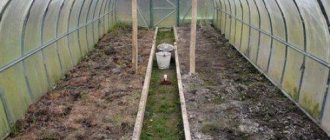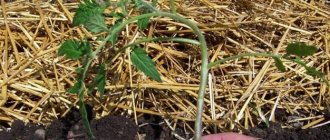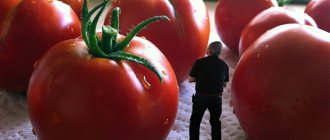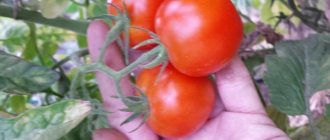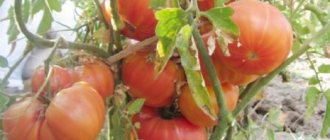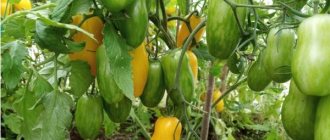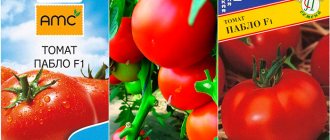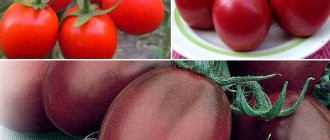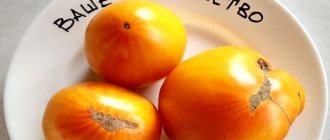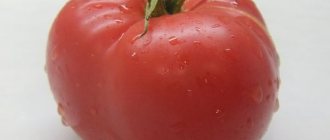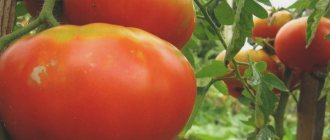The Red Coal tomato has an unusual and beautiful color. Dark “shoulders” and bright red fruits below give it a resemblance to hot coals. The taste is very sweet and pleasant, liked by many gardeners.
| Height | Landing location | Ripening time | Fruit color | Fruit size | Origin | Fruit shape |
| Tall | Greenhouse, Open ground | Mid-early | Bicolor | Average | Variety | Flat-round |
Description of the variety
In many seed catalogs, this tomato can be found under the original name RedCharcoal. The main characteristics of a tomato include:
- indeterminate plant requiring growth regulation;
- medium-early tomato, capable of fully developing in 90-110 days;
- The crop is productive, suitable for growing in different conditions, bears fruit well in open and protected ground.
Red coal bushes are powerful and tall. Often the plant can reach 1.80 centimeters. In greenhouse conditions, bushes are often found one and a half meters in height. Mandatory procedures when growing tomatoes of this variety are pinching and creating a support for gartering the plant.
Advice! It is recommended to carry out the first garter 30 days after transplantation of seedlings.
The bushes bear fruit better after the formation of a pair of stems. Although many farmers prefer to grow a single-stem variety, which can guarantee the gardener a good harvest.
Tomato Red Coal
photo author Evgeny Balashov
Description and characteristics of the Red Coal tomato variety, reviews, photos
The original name of the tomato is Red Charcoal .
Mid-early, indeterminate, productive variety of tomatoes for greenhouses and open ground.
The bush is powerful, up to 1.8 m high in the greenhouse and slightly lower in the greenhouse - 1.2-1.3 m. It requires tying it to a support and pinching it. The best results were obtained when forming a plant with 2 stems.
Basic qualities of fruits
photo author Mira Tom
The fruits are round, smooth, at the ripe stage the color is similar to smoldering coals - red below and black-violet above, weighing 100-200 grams, sweet, with subtle fruity notes. The pulp is juicy and red. There are many seeds in the fruit. These tomatoes are good for both fresh consumption and canning.
Tomatoes with this fruit color (with anthocyanin) are very useful for diseases of the cardiovascular system.
Productivity : up to 5.5 kg of fruits per plant (with proper agricultural technology).
Tomatoes Red coal on video
If you have grown Red Coal tomatoes, please write how you rate this variety. What was the yield and taste of the fruits like under your climatic conditions? If possible, attach a photo of the entire bush or individual fruits of this variety to the comment. Thank you!
Your reviews of the Red Coal tomato and additions to the description will help many tomato lovers evaluate this variety objectively and decide whether it is worth planting or not.
Description of fruits
The shape of Red Coal tomatoes is round and neat. The pulp is protected by a thick, glossy skin. The color is red, turning into crimson tones in the shoulder area. Sometimes the shade of a tomato at the stalk is similar to black-purple. This makes each tomato look like a piece of coal.
The weight of the fruit is 100-200 grams. It will not be difficult for experienced gardeners to increase the weight of tomatoes by removing several ovaries at the stage of their formation.
There is sweetness in the taste. The pulp is highly juicy, its color is red, but slightly different in tone from the outer shell. In the section you can see many seed chambers. Seed material can be saved for seedling production in the next season.
In terms of consumption, Red Coal can be called a universal tomato. The high nutritional value of the fruit makes it ideal for use in dietary dishes. It is known that the Red Coal variety is characterized by a high content of anthocyanin, which has a positive effect on the cardiovascular system and strengthens the body’s immune system.
Features of fruiting
The fruits are round in shape and have a smooth surface. The average weight of one vegetable is from 100 to 200 grams. Reviews from gardeners indicate the presence of a delicate aroma with subtle notes of fruity aroma.
The process of fruit ripening is interesting. At first they acquire a reddish tint, then in the area of the stalk the vegetables change color to a bluish tint, and towards the end of the fruiting period they acquire a coal black color.
The vegetable pulp is dense, deep red in color with a small number of seeds. The advantage of tomatoes is their high content of a substance such as anthocyanin, which has a beneficial effect on the functioning of the cardiac and vascular systems and reduces the risk of cancer. It is thanks to the high content of this element that vegetables acquire an unusual color.
The plant is characterized by high yields and with proper agricultural technology, up to 5.5 kg of tomatoes can be harvested from one plant bush. On average, one cluster of adult shoots contains 5 vegetables. Brushes with a lot of vegetables may need additional tying.
Advantages and disadvantages
The main advantages of the variety
- Great taste.
- The versatility of fruit use.
- Good immunity to diseases.
- The ability to achieve high yields when grown in open ground or greenhouse conditions. One plant can produce up to 6 kilograms of tomatoes.
- Easy to care for.
- The original appearance of tomatoes.
The disadvantages include the need to create support and periodically adjust the garter for the normal development of the plant.
What rules should you follow when growing seedlings?
Many gardeners give preference to seedlings grown independently, as they believe that the purchased material may be infected with some disease. Unreasonably grown seedlings give more confidence that the plant will be healthy and hardened. But for this it is necessary to maintain the correct temperature conditions and provide the necessary lighting.
The seeds of this variety are sown in accordance with the norm at the end of March, and under some weather conditions the sowing is postponed until the next month. This is necessary so that the seedlings can fully and completely strengthen, the ground warms up, so that weather conditions allow them to be removed into open ground. Before planting seedlings, it is recommended to harden them in the open air.
Do not forget about timely and moderate watering. The water should not be too cold. To ensure that there is no crust on the ground, it is worth regularly loosening the soil. This will ensure active intensification of plants. To preserve moisture under the bushes, you can mulch.
Fertilizing is usually carried out 3 times during the entire haymaking:
- when planting seedlings in the ground;
- during the flowering period;
- during fruit formation.
The composition of the fertilizer for the last two fertilizing should not contain nitrogen, in order to avoid excessive formation of stems and leaves to the detriment of fruit formation.
Landing rules
Professionals never miss the opportunity to grow tomatoes from their own seedlings. When buying seedlings in stores, there is a high probability of purchasing plants infected with dangerous diseases. Growing your own seedlings from disinfected seed material allows you to avoid this kind of problem. This gives farmers confidence in the quality of their tomatoes.
Red coal should be sown at the beginning or end of March. If necessary, you can postpone sowing to April. The main thing is that by the time the young bushes are fully strengthened, the weather has stabilized, the earth has warmed up and there is no risk of frost.
Gardeners should pay a lot of attention to the air temperature, which should not fall below 18 degrees, so that there are no signs of inhibition of tomato development. After complete pipping, do not forget about lighting, which plays an important role for the vertical growth of seedlings.
You can refuse fertilizing at this stage if the sowing was done in high-quality soil. Growers can help Red Coal tomatoes become stronger by taking them outside a week before transplanting. This reduces the risk of tomatoes dying after transplantation.
Care
Soil moisture plays an important role when growing Red Coal tomato. When planted deep, tomatoes will be able to take water from the depths of the soil during dry periods. But you shouldn’t leave the garden bed without irrigation. A crust may form on the top layer of soil, which interferes with proper air exchange and normal growth of tomatoes. Irrigation should be regular and moderate. Up to 5 liters of warm water should be poured weekly under each bush.
Important! For more active development of the root system, you need to regularly loosen the soil after watering.
Gardeners who do not have the opportunity to visit the site frequently can use a good layer of mulch, which not only prevents the spread of weeds, but also helps maintain soil moisture and performs a protective function during temperature changes.
Tomatoes planted in high-quality soil will not need frequent fertilization. It is enough to use fertilizing when transplanting seedlings, during flowering of the crop and after the formation of the ovary. The last two fertilizers should contain more potassium, calcium, magnesium and other components, with the exception of nitrogen. There should be a minimum of it in the fertilizer so as not to promote the development of green mass to the detriment of fruit formation.
Diseases and pests
Attentive farmers will not encounter serious problems when growing Red Coal tomatoes. The correct care regimen allows you to achieve excellent results in yield without the risk of developing dangerous diseases throughout the growing season.
Despite the fact that Red Coal is a mid-early variety, it manages to avoid diseases such as late blight. This crop has good immunity to cladosporiosis and gray rot.
Crop rotation, frequent cleaning of the beds from weeds and the use of preventive agents can protect planted tomatoes from viral diseases, bacterial infections, and insect infestations.
Reviews
- Evdokia, 29 years old:
I consider red coal to be a high-quality type. Regardless of what you have to put up supports, tie them up from time to time, and cut off unnecessary branches, the fruits delight with their rich taste, eye-pleasing color, and high yield. - Sergey Vladimirovich, 51 age:
At first I was a little wary. I didn’t want to have excessively tall plants on the site. But I was pleased with its high yield, elegant appearance, and high taste, which the tutti members of my family appreciated. - Lyudmila K., 30 years old:
My friend gave me seedlings of more or less bushes. And from them I got a noticeably larger harvest of tasty and bright tomatoes than from other tall varieties. I will openly grow this variety, which I recommend for other gardeners.

